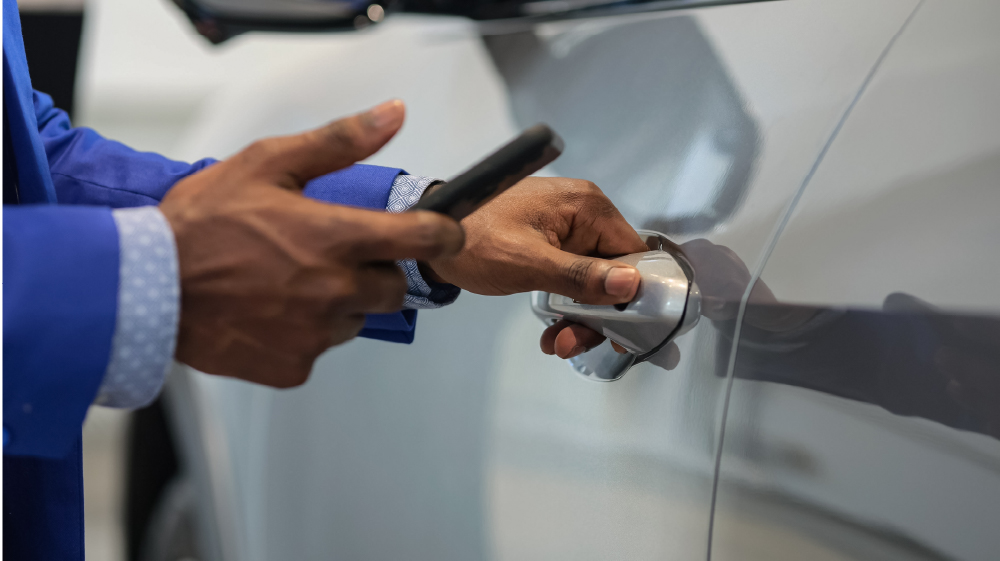learn about bluetooth
Bluetooth® Channel Sounding

Empowering everyday devices with true distance awareness
Bluetooth® Channel Sounding is a new secure, fine-ranging feature that promises to enhance the convenience, safety, and security of Bluetooth connected devices. By infusing billions of everyday devices with true distance awareness, Bluetooth® Channel Sounding unlocks a world of possibilities for developers, freeing them to imagine and create innovative experiences.
Key use cases
Bluetooth® Channel Sounding can bring true distance awareness to a wide array of connected devices, unlocking a world of possibilities for developers. When connected devices are distance-aware, a range of new possibilities emerge.
5.4 billion
annual shipments of Bluetooth® enabled devices in 2025

Bluetooth® ‘Find My’ solutions
Attaching Bluetooth® tags to personal items such as keys, wallets, backpacks, or luggage was just the beginning of the ‘Find My’ phenomenon. Now, a rapidly increasing number of Bluetooth devices embed ‘Find My’ capabilities, introducing the possibility of any Bluetooth connected device becoming a ‘Find My’ device.
Using Bluetooth® Channel Sounding, developers can now add true distance awareness to a ‘Find My’ device, improving the user experience and making it significantly easier and quicker for users to locate lost items.

Bluetooth® digital key solutions
Everything from cars, doors, gates, safes, and bikes are turning to Bluetooth® technology to enable keyless access and provide a more secure locking mechanism.
With Bluetooth® Channel Sounding, developers can enhance the security and user experience of digital key solutions, ensuring a lock only opens when the authorized device is within a certain distance. This significantly reduces the risk of unauthorized access from man-in-the-middle (MITM) relay attacks.

And many more
Bluetooth® Channel Sounding also has the potential to bring benefits to a wide range of connected device solutions, transforming the way we interact with our connected world. For instance, Bluetooth mice, keyboards, and game controllers, could automatically switch between active and inactive states based on their distance from a smartphone, tablet, or laptop, Bluetooth Human-Machine Interface (HMI) solutions can enhance personnel safety by only allowing usage from a safe distance, and Bluetooth device networks, such as those used for wireless lighting control, can self-optimize to enhance system performance. The opportunities are endless.
How it works
Bluetooth® Channel Sounding uses two proven ranging methods, phase-based ranging (PBR) and round-trip time (RTT), to enable secure, fine ranging between Bluetooth connected devices.
Phased-Based Ranging (PBR) for High Accuracy Distance Measurement
Bluetooth® Channel Sounding leverages phase-based ranging (PBR) to achieve precise distance measurements between two devices. In PBR, an initiator device sends a signal to a reflector device, which returns the signal. This process is repeated across multiple frequencies. The distance between the devices is calculated based on the phase differences between the transmitted and received signals over those frequencies.
Round-Trip Time (RTT) for Secure Distance Bounding
Bluetooth® Channel Sounding also incorporates a secondary ranging method called round-trip time (RTT) as a counter measure against sophisticated man-in-the-middle (MITM) relay attacks. In RTT, an initiator device sends cryptographically scrambled packets to a reflector device, which returns the packets. The distance between the devices is then calculated based on the time it took for the packets to travel back and forth.
RTT acts as a secure distance bounding technique, providing an independent distance measurement to cross-check the PBR measurement, significantly reducing the risk of MITM attacks. By combining PBR and RTT, Bluetooth® Channel Sounding enables secure and accurate distance measurements between devices.
Developer benefits
Accurate
Bluetooth® Channel Sounding leverages multi-channel, phase-based ranging (PBR) to enable highly accurate fine ranging between Bluetooth connected devices. Bluetooth® Channel Sounding offers centimeter-level accuracy over considerable distances, meeting the needs of the vast majority of applications and allowing even the simplest connected devices to take advantage of true distance awareness.
Secure
As the number of connected devices grows, so does the importance of maintaining the integrity of those connections. Bluetooth® Channel Sounding deploys robust, multi-layer security that includes a secondary ranging method, round-trip time (RTT) secure distance bounding, to add an extra layer of protection to counter sophisticated man-in-the-middle (MITM) relay attacks.
Ubiquitous
Bluetooth® technology is already embedded in all major consumer platform devices, including smartphones, tablets, and laptops. With Bluetooth® Channel Sounding, developers will now be able to add true distance awareness to Bluetooth connected devices without having to design in an additional radio technology.
With Bluetooth® Channel Sounding, we’re able to elevate the performance of ‘Find My’ applications by delivering centimeter-level accuracy, helping our customers find important items with greater ease. Additionally, Bluetooth® Channel Sounding enhances the security of digital key solutions, providing an extra layer of protection for keyless entry users.
-Joonsuk Kim, executive vice president of the System LSI Connectivity Team at Samsung Electronics
100%
of new smartphones include Bluetooth® technology
FAQ
Why is the feature called Bluetooth® Channel Sounding?
Channel sounding is a well-established term in radio frequency (RF) engineering that describes a technique used to characterize the properties of a radio communications channel. Since this new Bluetooth feature is used to calculate the precise distance between devices by characterizing the phase and time delay of a radio signal sent between them, Bluetooth® Channel Sounding was deemed an appropriate feature name.
What is the expected accuracy of Bluetooth® Channel Sounding?
The Bluetooth® Channel Sounding feature was designed to achieve centimeter-level accuracy, which means the accuracy of a distance measurement should be plus or minus tens of centimeters of the actual distance. In early implementations of the Bluetooth® Channel Sounding feature, we are already seeing accuracy levels of +/- 20 cm.
What is the maximum range Bluetooth® Channel Sounding can accurately measure distance?
The maximum range of Bluetooth® Channel Sounding depends on several factors, with one of the most significant being the transmission power of the Bluetooth devices involved. If both devices can transmit at the maximum allowed power level, accurate measurements at distances up to 150 meters can be achieved.
Can existing products be upgraded to add support for Bluetooth® Channel Sounding?
This is manufacturer dependent. Bluetooth® Channel Sounding introduces an entirely new protocol stack, including a Physical Layer (PHY) which may require a Bluetooth Low Energy (LE) integrated circuit (IC) upgrade to enable support for the feature. However, you should check with your device and/or product manufacturers to ultimately make this determination.
Does the Bluetooth® Channel Sounding feature define a distance measurement algorithm?
No. The Bluetooth® Channel Sounding feature does not include a distance measurement algorithm. It provides standardized techniques to determine signal phase and time delay information which can be used by an algorithm to calculate the distance between two devices. Since the appropriate distance measurement algorithm needed may vary depending on the use case, it was determined the Bluetooth® Channel Sounding specification would not define a specific algorithm. The necessary algorithm for the use case can be sourced or developed independently.
Will not having a single standardized algorithm impact the interoperability between devices from different manufacturers?
No. The algorithm only needs to be implemented by one side of the channel sounding session. The absence of a specified algorithm does not affect interoperability between two devices.
Are there use case specific Bluetooth profile specifications that use the Bluetooth® Channel Sounding feature?
There is a new Bluetooth® Ranging Profile specification in development. However, the ranging profile is not designed to be use case specific. This GATT specification will define how an application can configure and read results from a channel sounding procedure. The profile targets a broad range of use cases, including digital keys, locks, Find My solutions, and HMI (human machine interface) control solutions, to name a few.
Can Bluetooth® Channel Sounding be used in conjunction with other Bluetooth positioning features such as Bluetooth® RSSI and Bluetooth® Direction Finding?
Yes. Bluetooth® Channel Sounding can be used in conjunction with other Bluetooth positioning features, including RSSI and direction finding. For example, we are aware of upcoming solutions that plan to combine the use of Bluetooth® RSSI and Bluetooth® Channel Sounding, where RSSI will be used to determine presence, proximity, and course ranging when the devices are farther apart and Bluetooth® Channel Sounding will be used to increase accuracy as the two devices approach each other.
When are Bluetooth® Channel Sounding products expected to be available in the market?
We expect to see initial enabling technology products (e.g., chips, modules, and stacks) available this year and end-use products (e.g., mobile phones, tags, and fobs) supporting Bluetooth® Channel Sounding starting in 2025.